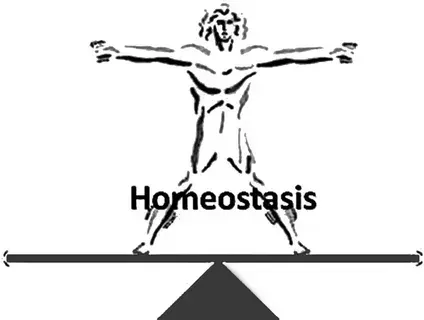Research & Science on Healing Stress Biology
Mechanisms of hormesis, homeostasis, and stress adaptation
Explore how controlled stress responses support healing, resilience, and longevity. This portal summarizes the science behind hormesis, homeostasis, and the balance between positive and negative stress.
The Science Behind Healing: How Controlled Stress Drives Resilience, Repair, and Longevity
Hormesis
Hormesis is a biphasic dose–response model in which low to moderate levels of stress activate adaptive repair mechanisms, while high or chronic stress leads to damage. These adaptive responses can enhance cellular resilience, expand homeostatic capacity, and potentially slow the aging process.


Homeostasis
Homeostasis refers to an organism’s capacity to maintain stable internal conditions despite external fluctuations. Hormetic stressors help restore and strengthen this balance, enhancing longevity and function
Positive (Eustress) vs. Negative (Distress) Stress
Beneficial, mild stress (e.g., physical activity, fasting, cold/heat exposure) that triggers adaptation and repair.
Chronic or intense stress that overwhelms homeostasis and accelerates aging and dysfunction.
Mechanisms & Stimuli
Highlight various hormetic categories:
Nutritional (e.g., caloric restriction, intermittent fasting)
Physical (e.g., exercise, thermal stress from heat/cold)
Chemical (e.g., mild phytochemicals like capsaicin, polyphenols)
Psychological/mental (e.g., cognitive challenges, meditation)
These stressors trigger pathways like Nrf‑2, stimulating cellular cleanup, repair, and increased resilience


Applications in Aging & Wellness
The hormetic approach is being studied as a promising strategy to support healthy aging, enhance stem cell survival, and expand the body's physiological adaptability.
“Mild, controlled stress can trigger systemic adaptations that help slow the biological aging process.”
Applications in Aging & Wellness
The hormetic approach is being studied as a promising strategy to support healthy aging, enhance stem cell survival, and expand the body's physiological adaptability.
“Mild, controlled stress can trigger systemic adaptations that help slow the biological aging process.”

HBOT & Cancer: Exploring the Therapeutic Role of Oxygen in Tumor Biology
HBOT delivers 100% oxygen at elevated pressures to increase tissue oxygenation, reduce hypoxia, and modify tumour micro environments.
Key findings:
Systematic reviews have found no evidence that hyperbaric oxygen therapy (HBOT) promotes tumor growth or recurrence. In fact, some research suggests it may suppress tumor progression in certain cancer subtypes.
Studies show that HBOT can improve drug delivery, enhance immune cell infiltration, and work synergistically with chemotherapy, radiotherapy, and immunotherapy in treating solid tumors.
In animal models, HBOT has demonstrated benefits such as improved angiogenesis, reduced hypoxia, and increased tumor cell apoptosis—particularly in lung cancer models.
Research on prostate cancer cell lines shows slowed tumor growth, increased therapy sensitivity, and anti-angiogenic effects with HBOT.
While HBOT alone may have limited direct survival impact in cancer-bearing models, it consistently enhances outcomes when combined with conventional therapies.
Internal Navigation Panel
Hormesis – Principles, mechanisms, and dose-response biology
Homeostasis – Regulation, adaptation, and repair systems
Stressors: Eustress vs Distress – Clinical examples, adaptation vs pathology
HBOT for Cancer – Evidence, mechanisms, and therapeutic potential
Frequently Asked Questions
What is Hormesis and how does it work?
Hormesis is a biphasic, dose‑response phenomenon where low-dose stressors stimulate adaptive repair and resilience, while high doses cause damage or toxicity. Examples include exercise, fasting, and mild thermal or chemical stress.
How is Homeostasis related to hormesis?
omeostasis is the ability to maintain internal balance despite external changes. Hormesis strengthens this homeostatic capacity especially as it declines with age—by activating adaptive responses through controlled stress
What is the difference between Positive (Eustress) and Negative (Distress) Stress?
Eustress: Beneficial, mild stress (like moderate exercise, sauna, fasting) that enhances resilience and adaptation.
Distress: Chronic or excessive stress that overwhelms biological systems and accelerates dysfunction
Can hormesis be applied to human aging and wellness?
Yes. Evidence shows mild hormetic stressors can improve cellular repair, stem-cell survival, telomere length, and mitochondrial health—supporting anti-aging and wellness strategies in humans
What are typical examples of hormetic stressors?
Common interventions include:
Exercise (HIIT, endurance)
Caloric restriction or intermittent fasting
Thermal stress (sauna, cold plunge)
Phytochemicals (capsaicin, green tea polyphenols)
Cognitive challenges or controlled mental load.
What is HBOT and how does it relate to hormesis?
Hyperbaric Oxygen Therapy (HBOT) involves breathing 100% oxygen at elevated pressure (typically 2–3 ATA), increasing tissue oxygenation. It works via hormetic mechanisms stimulating antioxidant defenses, angiogenesis, stem-cell activity, and gene expression to support healing and regeneration.
Is HBOT safe, and what are its side effects?
HBOT is generally safe when overseen by qualified medical professionals. Most patients encounter minimal side effects (e.g., ear pressure, temporary vision changes). Rare but serious complications—such as barotrauma or oxygen toxicity can occur, especially if improperly administered.
How many HBOT sessions are usually needed?
Treatment plans depend on condition, response, and health context:
Standard sessions last 60–120 minutes.
Frequency: 1–2 sessions per day, up to five days a week.
Duration: Some conditions require up to 40 sessions; many benefit within fewer than 20 sessions

Every patient must first be assessed by our specialists to understand their specific health needs and provide the most effective treatment options.
Navigation
Rejenivate
Contact Us
1309 Coffeen Ave, Suite 1200, Sheridan, WY 82801, United States
Opening Hours : Mon-Sat 9:00-20:00
USA/CAN : (202) 351-1497
Email : {{location.emial}}
© Copyright 2026. Rejenivate LLC . All rights reserved.
*REJENIVATE LLC. We look forward to helping you on your wellness journey. Services available to clients of Rejenivate are provided by an independently owned physician practice. Please note that a number of our services and products are not evaluated and/or approved by the FDA and those services and products are not intended to diagnose, treat, cure or prevent disease. We do not provide medical advice, diagnosis, or treatment through this Website or at its locations. We are not providing health care, medical or nutrition therapy services or attempting to diagnose, treat, prevent, or cure in any manner whatsoever any physical ailment, or any mental/emotional issue, or disease, or condition. We are not giving medical or psychological advice whatsoever. The purpose of this website or its locations is to explore current research and discussions of holistic and healthy lifestyle factors that are typically not discussed in the realm of modern allopathic medicine.
*Testimonials reflect individual experiences of real customers, are applicable solely to the individual depicted, and are not necessarily representative of all who use Rejenivate Wellness products and services. Results do vary and are unique to each individual. Customers providing testimonials are gifted free services for their time. Testimonials are not intended to make claims that these products can be used to diagnose treat, cure, mitigate or prevent any disease. Medical services available to clients of Restore are provided by an independently owned physician practice.
